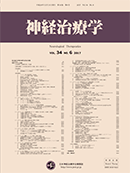Volume 40, Issue 1
Displaying 1-18 of 18 articles from this issue
- |<
- <
- 1
- >
- >|
-
2023Volume 40Issue 1 Pages 1
Published: 2023
Released on J-STAGE: April 20, 2023
Download PDF (222K)
-
2023Volume 40Issue 1 Pages 3-6
Published: 2023
Released on J-STAGE: April 20, 2023
Download PDF (428K)
-
2023Volume 40Issue 1 Pages 7
Published: 2023
Released on J-STAGE: April 20, 2023
Download PDF (197K) -
2023Volume 40Issue 1 Pages 8-11
Published: 2023
Released on J-STAGE: April 20, 2023
Download PDF (703K) -
2023Volume 40Issue 1 Pages 12-16
Published: 2023
Released on J-STAGE: April 20, 2023
Download PDF (932K) -
2023Volume 40Issue 1 Pages 17-22
Published: 2023
Released on J-STAGE: April 20, 2023
Download PDF (1760K) -
2023Volume 40Issue 1 Pages 23-27
Published: 2023
Released on J-STAGE: April 20, 2023
Download PDF (988K) -
2023Volume 40Issue 1 Pages 28-31
Published: 2023
Released on J-STAGE: April 20, 2023
Download PDF (390K) -
2023Volume 40Issue 1 Pages 32-35
Published: 2023
Released on J-STAGE: April 20, 2023
Download PDF (1275K) -
2023Volume 40Issue 1 Pages 36-39
Published: 2023
Released on J-STAGE: April 20, 2023
Download PDF (414K) -
2023Volume 40Issue 1 Pages 40-42
Published: 2023
Released on J-STAGE: April 20, 2023
Download PDF (316K)
-
2023Volume 40Issue 1 Pages 43-49
Published: 2023
Released on J-STAGE: April 20, 2023
Download PDF (682K) -
2023Volume 40Issue 1 Pages 50-53
Published: 2023
Released on J-STAGE: April 20, 2023
Download PDF (1248K) -
2023Volume 40Issue 1 Pages 54-58
Published: 2023
Released on J-STAGE: April 20, 2023
Download PDF (737K)
-
2023Volume 40Issue 1 Pages 59-64
Published: 2023
Released on J-STAGE: April 20, 2023
Download PDF (925K)
-
2023Volume 40Issue 1 Pages 65-68
Published: 2023
Released on J-STAGE: April 20, 2023
Download PDF (340K) -
2023Volume 40Issue 1 Pages 69
Published: 2023
Released on J-STAGE: April 20, 2023
Download PDF (206K) -
2023Volume 40Issue 1 Pages 70
Published: 2023
Released on J-STAGE: April 20, 2023
Download PDF (197K)
- |<
- <
- 1
- >
- >|
